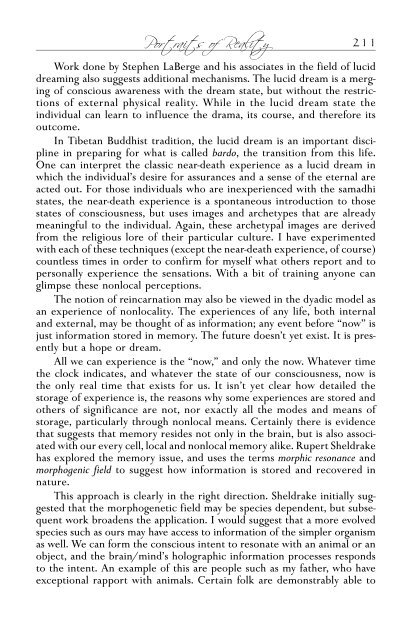edgar-mitchell
edgar-mitchell
edgar-mitchell
You also want an ePaper? Increase the reach of your titles
YUMPU automatically turns print PDFs into web optimized ePapers that Google loves.
106<br />
The Way of the Explorer<br />
take advantage of the ability. It was in this spirit of cooperation and open<br />
inquiry that Uri and I got down to business. He even agreed to restrain his<br />
usual showmanship and flamboyance.<br />
The resident scientists hosting the experiments were Dr. Harold Puthoff<br />
and Russell Targ, both widely respected physicists at the Stanford Research<br />
Institute. Both men had made their reputations in more conventional fields<br />
of science, but they too were convinced that this was something that demanded<br />
their attention. They designed many of the experiments we would<br />
conduct to test for Uri’s abilities. On several occasions they were aided by<br />
Dr. Wilbur Franklin of Kent State University, a metallurgist who examined<br />
many of the materials used in the experiments. They had each been<br />
working in parapsychological studies for some time now, and were well<br />
experienced in this type of research. Targ was also a skilled amateur magician,<br />
which blunted the first claim of critics—that “psychic stuff” was just<br />
smoke and mirrors. The first effort of the researcher is always to determine<br />
validity of the event. But the important work, once validity is established,<br />
begins with the search for clues to the mechanisms permitting these<br />
phenomena to occur so that a workable theory can be constructed.<br />
One type of experiment Puthoff and Targ created is called remote viewing,<br />
in which random “targets” are picked, and the subject (Uri, in this case) is<br />
to describe the unknown object. 4 Typically, these targets would be chosen<br />
by invited outside scientists, sealed in an envelope, then selected at random.<br />
Uri, in a room all by himself, where he was isolated from receiving<br />
any possible information, would attempt to describe the setting. We found<br />
he could do just that.<br />
Nearly every time Uri was given a target, he would promptly draw—<br />
quite recognizably—what lay there. This type of experiment was usually<br />
conducted in a double-blind fashion so that no one knew the correct answer<br />
before the tests were complete and checked by impartial observers.<br />
In some variations of this experiment a Faraday cage was used, which<br />
isolates normal electromagnetic signals. Puthoff and Targ went on to conduct<br />
the same experiment with dozens of other people, both those claiming<br />
psychic abilities and those not. Eventually they discovered that most any<br />
willing person with a bit of training could get significant results, supporting<br />
the idea that this was not only a natural function, but a common one as<br />
well.<br />
It was also discovered in subsequent tests that the brain waves of two<br />
individuals separated and isolated by a Faraday cage could synchronize<br />
their brain waves. A light pulsed in the eyes of one would cause a certain<br />
EEG pattern. The second person, by merely thinking of the first person,<br />
would suddenly acquire the same EEG pattern. Somehow there seemed to<br />
be some sort of communication occurring between the two that we didn’t<br />
know was possible. 5


